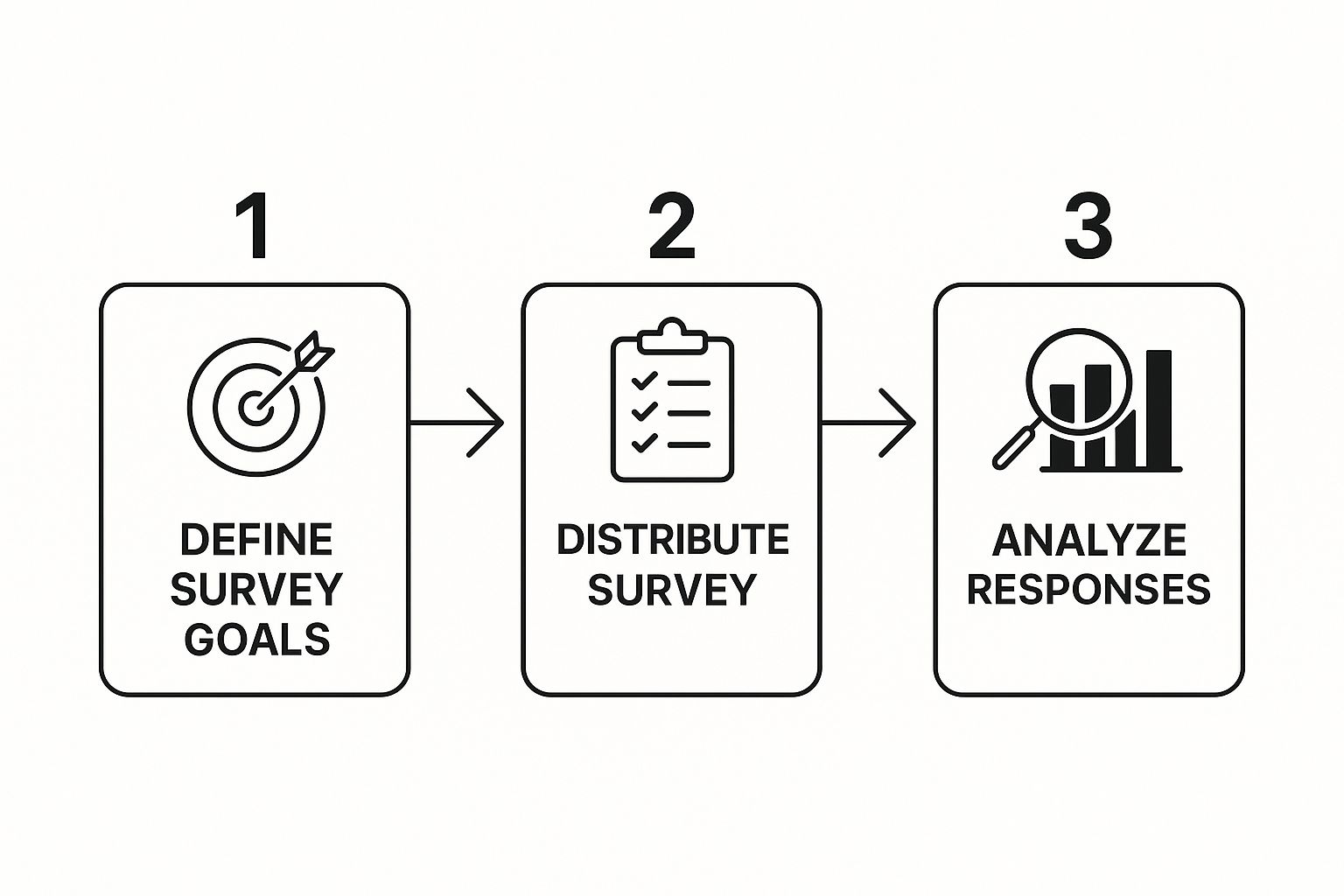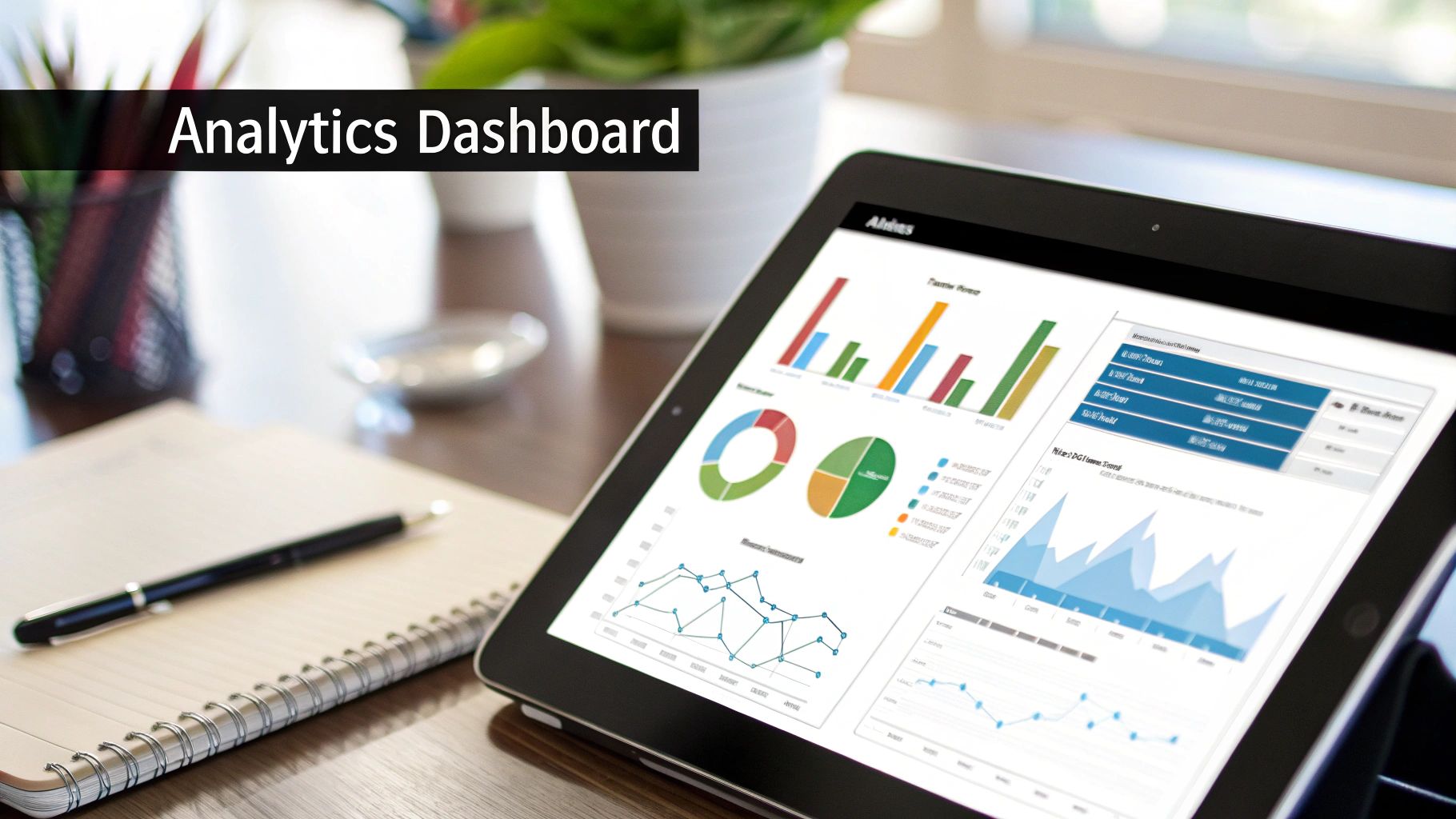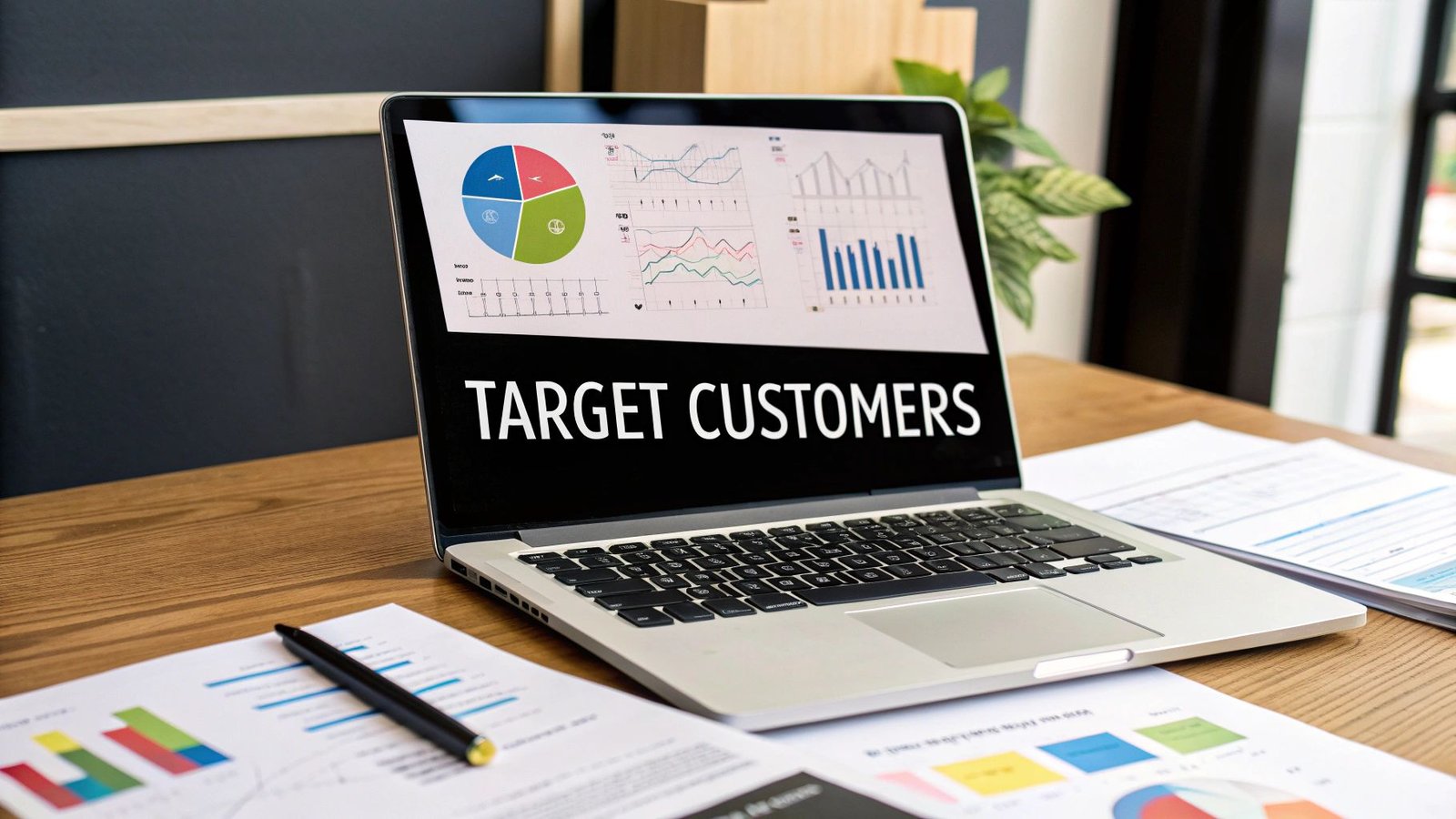It's tempting to think you know who your customers are. But so often, what we think of as our target audience is really just a rough sketch based on guesswork. To get real traction, you have to move past those broad assumptions and get specific. This means looking beyond the obvious demographics and digging into what makes your ideal customers tick: their motivations, their habits, and the real problems they need solved.
This isn't just about better marketing; it’s about building a smarter business from the ground up.
Moving Beyond Guesswork in Customer Targeting
A great product isn't enough to guarantee success. The real foundation is a crystal-clear understanding of the people you’re building it for. For a long time, businesses got by with basic demographic data—age, location, gender. Frankly, that just doesn't cut it anymore. Sticking to that old playbook is a surefire way to burn through your marketing budget with very little to show for it.
Today, the goal is to create a complete, three-dimensional picture of your ideal client by layering different kinds of data. It’s like going from a fuzzy, black-and-white photo to a full-color, high-definition video. Getting this right is the most important step you can take before you even think about research or segmentation tactics.
Building Your Customer Profile, Layer by Layer
To truly get inside your customer's head, you need to look at them from a few different angles. Each piece of information gives you a new perspective, and when you put them all together, you get a profile that's both powerful and incredibly accurate.
This process generally breaks down into four key areas of data.
The Four Pillars of Customer Data
Think of these four categories as the building blocks for any solid customer profile. You need a bit of each to create something that’s stable and useful.
| Data Type | What It Tells You | Example |
|---|---|---|
| Demographic | The basic "who" of your audience. | A 35-year-old marketing manager living in a major city. |
| Psychographic | The "why" behind their decisions and actions. | Values sustainability, early adopter of new tech, seeks work-life balance. |
| Behavioral | The "how" they interact with products and brands. | Buys software via subscription, reads industry blogs, prefers email updates. |
| Geographic | The "where" that shapes their needs and environment. | Located in a competitive urban market, works in a hybrid office setting. |
By combining these data types, you stop marketing to a vague, faceless crowd and start having meaningful conversations with the people who are most likely to become your best customers.
It’s the difference between shouting into an empty room and having a one-on-one conversation with someone who is genuinely interested in what you have to say.
Relying on old-school, broad demographic targeting is a recipe for disaster. I've seen it happen time and again. One startup founder I know invested $50,000 targeting the generic segment 'millennials in tech' and ended up with zero leads. Not a single one. That’s a painful lesson in the gap between who you think your customer is and who they actually are.
You can find more insights on how data shapes modern buyer personas and read through similar cautionary tales to avoid making the same mistakes.
Uncovering Insights from Your Existing Data

Before you go hunting for new customers, the smartest first move is to look right under your own roof. You're already sitting on a goldmine of information—your existing customer base. These are the people who already love what you do, and they hold the blueprint for who you should be targeting next.
Your best, most loyal, and most profitable clients aren't just entries in a spreadsheet. They're real-world proof that your product or service works. By digging into who they are and what they have in common, you can build a powerful, data-backed model of your ideal customer.
It all starts by tapping into a few key sources of information that are likely already at your fingertips.
Start with Your Sales and CRM Data
Your CRM is your single source of truth. It’s where the story of your most successful relationships is written. Dive in and start looking for the common threads that tie your best customers together. Think beyond just the biggest spenders; who has the highest lifetime value? Who sends the most referrals your way?
Get specific and look for quantifiable traits that keep popping up.
- Industry and Company Size: Do your top clients all seem to come from a specific sector, like SaaS or manufacturing? Are you consistently winning with small businesses or landing deals with large enterprises?
- Job Titles: Who are you actually selling to? Is it VPs of Sales, Marketing Managers, or CTOs? Knowing the decision-maker’s title is crucial.
- Geographic Location: Do you have a hotbed of happy customers in a particular city or region? This could signal a strong, untapped market fit.
- Sales Cycle Length: How long does it typically take to close a deal with an ideal customer? A shorter cycle often points to a more urgent need for what you offer.
Pro Tip: Don't just analyze the wins. Look at the deals you lost or the customers who churned. Understanding why someone isn't a good fit is just as illuminating as knowing why someone is.
Analyze Your Website and Social Analytics
Next, let’s look at your digital presence. Who is already showing interest in your brand online, even if they haven't bought anything yet? Your website and social media analytics hold the answers.
Google Analytics is fantastic for this. It can show you the demographic and interest data of your visitors. Are certain age groups spending more time on your site? What are their top interests according to Google’s affinity categories? This information helps you paint a much broader picture of the audience your message is attracting.
In the same way, your social media analytics provide a window into your followers' world. Pay close attention to the content that sparks the most conversation and engagement. Those likes, shares, and comments are clues to the pain points that really matter to your potential customers.
When you blend these digital insights with your hard sales data, you create a far more complete and accurate profile of who you should be talking to. It’s this powerful combination that forms a core principle in learning how to generate more leads for your business.
Building Customer Personas That Actually Work
You've got the data. Spreadsheets, analytics, CRM reports—it's all there. But raw data doesn't tell a story. This is where we stop looking at numbers and start building a real, three-dimensional picture of our ideal customer. We're creating a customer persona.
Think of it less as a marketing exercise and more as developing a character for a movie. A great persona isn't just a collection of facts; it’s a narrative that gives your entire team a shared understanding of who they’re working for. It’s the compass that guides every product decision, every piece of content, and every marketing campaign.
Turning Data Into a Cohesive Story
Now it's time to pull everything together. Comb through your CRM, your website analytics, customer interviews, and survey results. You're on the hunt for patterns—the common threads that tie your best customers together. What problems are they all trying to solve? What really gets them to make a decision?
This is more art than science. You're not just listing data points; you're interpreting them to build a personality.
- Goals: What's their end game? What are they trying to accomplish in their job or their life?
- Challenges: What’s constantly getting in their way? What are the biggest headaches they face?
- Motivations: What's the "why" behind their actions? Are they chasing a promotion, trying to save time, or looking to align with a cause?
- A Day in the Life: What does their typical day look like? What tools are always open on their desktop? Where do they hang out online for news and advice?
This sample persona from Wikipedia is a great example of how you can combine different data points to create a profile that actually feels human.

It’s simple but effective. There’s a name, a face, and a clear summary of their goals and frustrations. It’s memorable and easy for anyone on the team to reference.
The best personas feel like real people. Give them a name. Find a stock photo that fits. Write a quick bio. Your goal is to create a character so vivid that people in meetings start asking, "Yeah, but what would 'Marketing Manager Maria' think of this?"
B2B and B2C Personas: Two Different Worlds
The details you focus on will shift dramatically depending on who you sell to. If you’re a B2B company, you’re solving professional problems. For B2C, you’re tapping into personal lifestyles and values. They require a completely different lens.
Let's break down the distinction with a clear comparison.
B2B vs B2C Persona Development
This table highlights how the focus changes when you're building a persona for a business audience versus a direct consumer.
| Element | B2B Persona Focus (e.g., 'Marketing Manager Maria') | B2C Persona Focus (e.g., 'Eco-Conscious Alex') |
|---|---|---|
| Primary Goal | Increasing team efficiency and proving marketing ROI. | Finding high-quality, sustainable clothing that lasts. |
| Main Challenge | Juggling too many software tools with a limited budget. | Distinguishing truly ethical brands from greenwashing. |
| Key Motivator | Gaining recognition for driving measurable business growth. | Making purchasing decisions that align with personal values. |
| Information Source | Industry blogs, LinkedIn, and peer recommendations. | Instagram influencers, ethical fashion blogs, and brand websites. |
As you can see, context is everything. Maria is driven by professional metrics and peer validation, while Alex is motivated by personal ethics and social proof from trusted influencers.
When you tailor your personas this specifically, they become incredibly powerful. This isn't just an academic exercise; it's the foundational work needed to figure out how to identify target customers who will stick around. It ensures your marketing efforts aren't just shouting into the void but are having a meaningful conversation with the right people.
Executing Advanced Market Segmentation
So, you’ve built your first customer persona. That's a fantastic starting point, but it's just one piece of a much larger puzzle. To really make an impact, you have to look beyond that single character sketch and get a feel for the entire landscape of your market. This is where advanced market segmentation shines—it’s how you stop shouting one message at everyone and start having a series of precise, meaningful conversations.
The idea is to blend the hard facts of demographics with the real-world patterns of behavior and the "why" behind psychographics. This lets you carve out distinct, nuanced customer groups. Instead of one generic campaign, you can craft specific messages for each segment, which almost always leads to better engagement and higher conversion rates.
Combining Data for Deeper Insights
Great segmentation isn’t about picking one type of data; it’s about layering them to get a complete picture.
Let's say you're a B2B software company. Demographics tell you you're selling to marketing managers. Okay, but that’s pretty broad, right? That’s the who.
Now, let's add some behavioral data. You notice a specific group consistently downloads your whitepapers and shows up for your webinars. This tells you how they interact with your brand. We're getting warmer.
Finally, you layer on psychographics and uncover that this group is driven by career growth and loves innovative, time-saving tools. That's the why.
All of a sudden, you're not just targeting "marketing managers." You’re talking to "Ambitious Innovators"—a well-defined group with clear motivations that you can speak to directly in your copy, ads, and content.
This multi-dimensional view is really the core of modern customer identification. It lets you anticipate what your customers need instead of just reacting, making your marketing feel less like an ad and more like a genuinely helpful solution.
To do this well, you need to pull from a lot of different data sources. Companies are collecting huge amounts of information, from demographic details to complex behavioral patterns. This rich data lets businesses move past simplistic groupings and develop nuanced personas that reflect how people actually think and act. There's a lot to learn about these emerging techniques and how they're reshaping the marketing world.
From Theory to Action: A Practical Example
Let's bring this down to earth. Imagine an e-commerce brand that sells eco-friendly home goods. A basic persona might be "Eco-Conscious Alex." But with some smart segmentation, you'll quickly realize there are at least two very different groups hiding under that umbrella:
- The Budget-Minded Recycler: This person is motivated by sustainability, sure, but also by saving money. They buy in bulk, jump on discount codes, and hang out in Facebook groups dedicated to frugal, eco-friendly living.
- The Premium Sustainability Advocate: This person values aesthetics and brand ethics just as much as the environmental impact. They follow high-end design influencers on Instagram, read deep-dive articles about material sourcing, and have no problem paying more for a certified organic product.
You’d never market to these two groups the same way. The first segment gets an email blast about a 20% Off Bulk Refills sale. The second gets a targeted Instagram ad with a beautifully shot video of the artisan who handcrafts their ceramic soap dispensers. It's the same brand, but by understanding the different segments, you can create radically different—and far more effective—messaging. This is exactly what well-executed customer segmentation strategies can do for your business.
So, where do you begin? It all starts with collecting the right data. The infographic below maps out the essential steps for using surveys to gather these crucial insights.

As the visual shows, effective segmentation kicks off with a clear goal. From there, it's about strategic distribution and careful analysis to find the hidden patterns in customer responses. Following a structured process like this ensures the data you gather is truly actionable and can directly shape your segmentation efforts.
Using AI for Predictive Customer Targeting

The future of identifying your best customers isn't some far-off concept anymore. It’s here, and it runs on artificial intelligence. We're moving beyond static customer personas and basic segmentation into a much more dynamic way of understanding who is likely to buy from you next.
This is a big shift. Instead of just analyzing what people did in the past, we can now make surprisingly accurate predictions about what they’ll do in the future.
AI platforms do this by crunching massive amounts of data—far more than any human team could handle. They sift through your CRM history, website interactions, social media chatter, and third-party data to find subtle patterns that would otherwise go unnoticed. The result is a much sharper, more predictive picture of your ideal customer.
The Power of Predictive Intent Modeling
One of the most practical applications of AI in sales and marketing is predictive intent modeling. Think of it as a radar for finding prospects who are actively showing buying signals, even if they've never heard of your company.
AI algorithms are constantly scanning for signals like:
- Someone suddenly consuming a lot of content on a specific topic.
- A key decision-maker changing jobs, signaling new budgets or priorities.
- A company rapidly hiring for certain roles, indicating growth and new needs.
When AI flags these signals, it allows your team to focus its energy on leads that are already warm. It flips your strategy from being reactive to proactive, which can supercharge your entire outbound lead generation process.
AI doesn't just find more leads; it finds the right leads at the right time. It filters out the noise, allowing you to engage with prospects who are already halfway to a buying decision.
This focus on prediction is becoming a must-have. The global AI market is expected to grow at a compound annual growth rate of 35.9% between 2025 and 2030, and marketing AI tools are expanding even faster. These platforms blend real-time data to create personalized targeting that old-school methods simply can't compete with. If you want to dive deeper, you can explore more about these AI-powered customer segmentation trends on SuperAGI.
From Static Personas to Dynamic Profiles
Let’s be honest: traditional customer personas are just a snapshot in time. They’re a great starting point, but they get stale fast as markets and behaviors change. AI offers something better: dynamic persona creation.
This means your customer profiles are constantly being updated in real time as new data flows in.
Imagine a persona that actually evolves as a prospect moves through their buying journey. Their challenges, what content they prefer, and how they engage are all refreshed automatically. This lets your marketing adapt on the fly, ensuring your messaging always hits the mark. For instance, a profile could shift its focus from "information gathering" to "comparing solutions" based on the prospect's recent web activity.
Of course, with this power comes responsibility. Using AI to target customers means you have to be serious about ethical considerations like data privacy and algorithmic bias. Being transparent about how you use data is non-negotiable if you want to build long-term trust. When handled correctly, AI becomes an incredible partner for understanding your audience on a much deeper level.
Common Questions We Hear About Finding Customers
https://www.youtube.com/embed/HkKf3Mhszww
When you first start digging into customer identification, a few practical questions almost always pop up. Getting these sorted out early on helps you build a much stronger strategy and move forward without second-guessing yourself.
Let's walk through some of the things people ask us most often.
How Often Should I Update My Customer Personas?
This is a big one. The simple answer is that your customer personas are living documents, not a "set it and forget it" project you finish once. Markets shift, people’s needs change, and your understanding of who you’re selling to needs to evolve right along with them.
A good baseline is to schedule a formal review of your personas at least once a year.
But, more importantly, you should be ready to revisit them any time a major change happens in your business. These moments are your cue to take another look:
- You're launching a major new product that could appeal to a totally different group of people.
- Your marketing strategy or brand message is getting a significant overhaul.
- You start noticing weird shifts in customer behavior or buying patterns in your analytics data.
Stale personas lead to stale marketing. If you’re constantly listening to customer feedback and keeping an eye on your analytics, you’ll have the insights you need to keep your profiles sharp and genuinely useful.
Another point of confusion is the difference between a market and a customer. They're related, for sure, but they serve completely different purposes in your strategy.
Think of it this way: a 'target market' is the broad group you want to reach, like 'women aged 25-40 in urban areas.' A 'target customer,' on the other hand, is a detailed, fictional person who represents your ideal buyer within that market—someone with real goals and specific problems.
Basically, the market is the whole ocean. The customer is the specific fish you’re trying to catch. Your persona—say, 'Creative Professional Chloe, 32, who values sustainability'—is the actual person you're talking to with your marketing.
Can Small Businesses Really Do This on a Tight Budget?
Yes, absolutely. It's easy to assume this kind of research requires a massive budget and expensive AI tools like the big corporations use, but that's not the case. Small businesses can get fantastic results with free or low-cost methods; you just have to be a bit more resourceful.
The key is focusing on the qualitative side of things.
Start by digging into your own sales records—who is already buying from you? Use free tools like Google Analytics to see who's visiting your website and what they're doing. You can build simple but effective customer surveys with Google Forms and just talk to your followers on social media to learn what they care about.
Honestly, some of the most powerful insights come from simply having a real conversation with your happiest, most loyal customers.
Ready to stop guessing and start targeting the right decision-makers? The Nordic Lead Database gives you access to the most extensive database of companies and key contacts in the Nordics. Find your ideal customers and build your pipeline faster.
